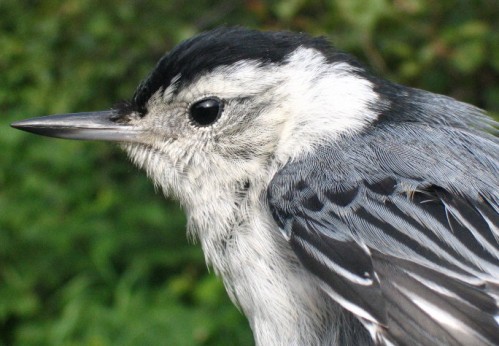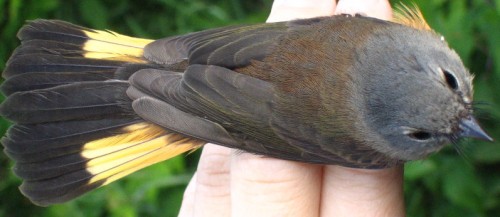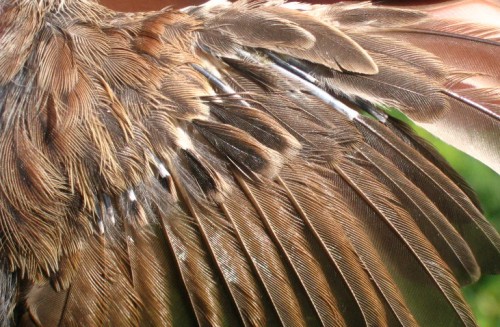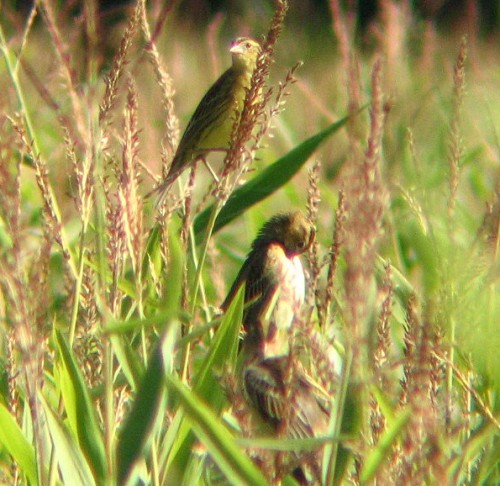|
McGILL BIRD OBSERVATORY |
|||||||||||||||||||||||||||||||||||||||||||||||||||||||||||||||||||||||
Welcome
to the McGill Bird Observatory weekly report.
Click here for a complete listing of our archives.
Bander-in-charge:
Seabrooke Leckie Notes: At dawn of the opening morning of week 4, staff were greeted with the sounds that would become the background chorus for the week: the call notes of flocks of warblers as they began to wake up. Although banding numbers were about average on the 22nd, small mixed flocks of warblers and flycatchers were observed all morning. A high count of 5 Northern Waterthrush were banded on Tuesday, and a total of 7 were detected on both Tuesday and Wednesday. Waterthrush numbers seem to be up at many stations, which suggests a very successful breeding year for them. Calm conditions early on Wednesday encouraged another small push of warblers to move in, though just a small number were banded. The 23rd saw the highest total of Bobolinks of the season to date. These birds haven't been recorded often at MBO in previous seasons, but this fall several flocks have been using the cornfield next to the MBO site for daytime foraging (and likely roosting). The 24th was the second busiest day of the week, with a total of 47 birds captured during the morning. The most numerous of the birds captured were Magnolia Warblers, with 13 banded, but small numbers of Northern Waterthrush and Nashville Warbler were also present. The first Myrtle Warbler banded this fall made its appearance on Thursday, as well as the first Brown Thrasher. However, the highlight of the morning was a White-breasted Nuthatch, only the third to be banded by MBO - despite being a relatively common bird at the site, they just don't seem to get caught that often! Overcast and cool conditions on Friday encouraged some early migrant movement at the site, but as the clouds cleared and the sun came out activity dropped off, so about half of the day's captures were from the first hour. A Warbling Vireo was caught late in the morning, and the first male Black-throated Blue Warbler was part of the early flocks. The week's 2 most interesting captures, from an oddities point of view, were both caught on Friday. The first was a hatch-year male American Redstart showing unusually bright orange patches for his age (usually hatch-year males will show yellowish-orange patches), as well as reddish tinting to the feathers of his back and wings. The second was a hatch-year Song Sparrow completing an unusual - and previously undocumented - moult pattern. Photos of both are featured below.
Things slowed down significantly for the 26th, despite cool temperatures and north winds. A meager 14 birds were captured on this morning, although this included our 100th species detected this fall at MBO: a hatch-year Blackpoll Warbler. Late in the morning, as the sun rose higher and the air started to warm up, we were treated to a small movement of diurnal raptors that included Turkey Vulture, Northern Harrier, Red-shouldered Hawk, Red-tailed Hawk and Broad-winged Hawk. Activities on the 27th were extremely limited as we had our first morning rainfall of the season. Only 4 net-hours were squeezed in before the rain began to fall, and just 2 birds were captured. A rather soggy BIC completed census, and total species detected for the morning was a season low, due to weather conditions and reduced observation time. However, as if to make up for lost time, Monday was our busiest day of the season so far. Staff were kept busy with 81 birds captured. Flocks of warblers were moving through the area in small numbers, and the majority of the birds caught were from foraging groups entering a net together (imagine 15 warblers all in one net!). Among the interesting warblers banded were the first Bay-breasted Warbler of the season, a female Blackburnian, 2 Blackpoll, a Canada, a Mourning, 5 Wilson's and an amazing 21 Magnolia Warblers!
This week’s top ten highlights the warbler push that has gone through MBO this past week, with all but 2 spots on the banding list occupied by warblers! The apparent leap to the top that the Common Grackles made this week is slightly deceptive, as it’s mostly due to a few large flocks moving through on one day, and similarly nearly half of the crows observed this week were recorded on a single morning. With north winds and cool overnight temperatures forecasted for most of the upcoming week, we can likely expect more of the same in the days that follow!
|





